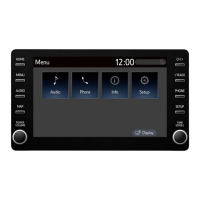80
3-6. Tips for operating the audio/visual system
COROLLA_HV(TMUK)_OEM_MM_(EE)
3-6.Tips for oper ating the audio/v isual syste m
●
The use of a cellular phone inside or
near the vehicle may cause a noise
from the speakers of the audio/visual
system which you are listening to.
However, this does not indicate a mal-
function.
Usually, a problem with radio recep-
tion does not mean there is a prob-
lem with the radio it is just the
normal result of conditions outside
the vehicle.
For example, nearby buildings and
terrain can interfere with FM recep-
tion. Power lines or phone wires
can interfere with AM signals. And
of course, radio signals have a lim-
ited range. The farther the vehicle
is from a station, the weaker its sig-
nal will be. In addition, reception
conditions change constantly as the
vehicle moves.
Here, some common reception
problems that probably do not indi-
cate a problem with the radio are
described.
■
FM
Fading and drifting stations: Gener-
ally, the effective range of FM is
about 40 km (25 miles). Once out-
side this range, you may notice fad-
ing and drifting, which increase with
the distance from the radio trans-
mitter. They are often accompanied
by distortion.
Multi-path: FM signals are reflec-
tive, making it possible for 2 signals
to reach the vehicle’s antenna at
the same time. If this happens, the
signals will cancel each other out,
causing a momentary flutter or loss
of reception.
Static and fluttering: These occur
when signals are blocked by build-
ings, trees or other large objects.
Increasing the bass level may
reduce static and fluttering.
Station swapping: If the FM signal
being listened to is interrupted or
weakened, and there is another
strong station nearby on the FM
band, the radio may tune in the
second station until the original sig-
nal can be picked up again.
■
AM
Fading: AM broadcasts are
reflected by the upper atmosphere
especially at night. These
reflected signals can interfere with
those received directly from the
radio station, causing the radio sta-
tion to sound alternately strong and
weak.
Station interference: When a
reflected signal and a signal
received directly from a radio sta-
tion are very nearly the same fre-
Operating information
●
To avoid damage to the
audio/visual system:
• Be careful not to spill beverages
over the audio/visual system.
Radio

